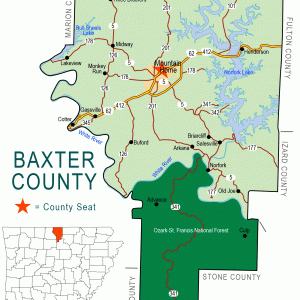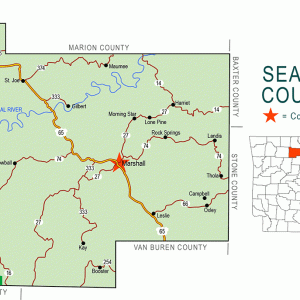calsfoundation@cals.org
Big Flat (Baxter and Searcy Counties)
| Latitude and Longitude: | 36°00’18″N 092°24’16″W |
| Elevation: | 1,237 feet |
| Area: | 1.07 square miles (2020 Census) |
| Population: | 88 (2020 Census) |
| Incorporation Date: | May 1, 1939 |
Historical Population as per the U.S. Census:
|
1810 |
1820 |
1830 |
1840 |
1850 |
1860 |
1870 |
1880 |
1890 |
1900 |
|
– |
– |
– |
– |
– |
– |
– |
– |
– |
– |
|
1910 |
1920 |
1930 |
1940 |
1950 |
1960 |
1970 |
1980 |
1990 |
2000 |
|
– |
– |
– |
210 |
197 |
217 |
189 |
150 |
93 |
104 |
|
2010 |
2020 |
|
|
|
|
|
|
|
|
|
105 |
88 |
|
|
|
|
|
|
|
|
Big Flat is a town on State Highway 14, mostly in southern Baxter County but straddling the Searcy County line. It is just outside the Ozark National Forest. One of the earliest settlements of northern Arkansas, Big Flat long flourished because it was isolated from other settlements by the hills and forests of the region. The town did not incorporate, though, until 1939.
Big Flat was named for a plateau in the Leatherwood Mountains of the Ozark Mountain range. For thousands of years, the area was visited by hunters, fishers, and gatherers of food; the Osage came down from what now is Missouri to collect food to bring back to their homes in the north. White settlers began to arrive at Big Flat as early as 1820, and Lewis Wallis and W. B. Lackey had established a store there before the Civil War. A post office was established in 1854.
During the Civil War, the Confederate government operated a saltpeter mine in Saltpeter Cave, located at the confluence of Spring Creek and Big Creek northwest of Big Flat. Federal soldiers hanged one local resident who had resisted serving on either side during the war but who was acting as lookout for the miners in the cave. Local lore describes another man who lived in a cave to avoid the war. He was trapped for years after a landslide until he was rescued by railroad workers building a line through the area in the 1870s. Bushwhackers devastated the community of Big Flat and the farms around it during the war.
The Big Flat post office, which evidently closed during the war, was reopened in 1873. John Baker built a store in Big Flat in 1878 that was operated by his brother Asa, one of a chain of Baker Brothers Stores in northern Arkansas. Supplies came to Big Flat by means of wagon train, steamboats traveling the White River to the mouth of Sylamore Creek, or horseback from Mountain Home (Baxter County), the county seat. Later in the nineteenth century, and extending into the 1930s, the timber industry became established in the area. This proved to be the most significant employer for Big Flat residents.
It is not recorded when Big Flat began its first school, but, according to records from 1931, Big Flat’s school district was the thirty-second district to be organized in Baxter County. By 1931, the school had three teachers and 137 students. In 1938, the National Youth Administration built a gymnasium for the Big Flat school; the building was added to the National Register of Historic Places on November 19, 1993. In 1985, the Big Flat School District underwent consolidation with the Fifty-Six (Stone County) school district; in the twenty-first century, the community is divided between the Mountain Home School District and the Searcy County School District.
After the community remained unincorporated for more than a century, citizens voted to incorporate Big Flat as a town in early 1939. By 1973, the town was described as “a thriving business and school center for the residents of southernmost Baxter County.” The dirt and gravel road connecting Big Flat to Mountain Home through the national forest was finally paved in 1995, making travel easier in the south end of the county. This road, designated State Highway 341, is also known as Push Mountain Road.
Businesses in Big Flat in 2010 included two grocery stores, a liquor store, and an excavating company. Livestock are raised nearby on G & G Ranch, operated by Donald Graves. Gravity BrewWorks, a microbrewery, opened in Big Flat in late 2013.
Author Robbie Tilley Branscum was born in Big Flat in 1934 and lived there for a time as a child.
For additional information:
Ballentine, R. H. “Early Settlers Survey.” Baxter County History 32 (July–September 2006): 85–88.
Baxter County Historical Society. History & Families, Baxter County, Arkansas. Paducah, KY: Turner Publishing Company, 2003.
McNeil, W. K. That’s the Way I Heard It: Some Folk Narratives and Other Folklore from Big Flat, Arkansas. Big Flat, AR: Big Flat Senior Center, 1983.
Messick, Mary Ann. History of Baxter County, Centennial Edition, 1873–1973. Mountain Home, AR: Mountain Home Chamber of Commerce, 1973.
Steven Teske
Butler Center for Arkansas Studies







My mother’s family was from Big Flat. Rose, Treat, Vickers etc.
My grandfather Herbert Frances Rose was born in Big Flat on July 16, 1906.
My grandfather was from Big Flat
My mother was from Big Flat.